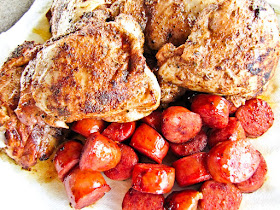Sauteed red pepper, carmelized onion, sausage, and olive pizza
We eat a lot of seafood while we cruise - I mean a LOT of seafood, just-caught and fresh from the saltwater seafood. We catch enough to eat, but don't can or even freeze any to keep long-term. Nothing beats really fresh fish (or crab or shrimp), so we rarely eat any seafood during the winter.
Ah, but it's a different story with a few other food items, like pizza. Pizza is essential, and I crave it year round - on the boat, at the house, on a trip, it doesn't matter where. But bad pizza is worse than no pizza, so we dine most often on homemade pizza. While afloat we've enjoyed crab pizza, smoked salmon pizza, halibut pizza and of course, the usual vegie, cheese and/or meat varieties. (Note to niece Hilary: I'm still working on the sauce for the halibut version.)
We're especially fond of thin-crust pizza, and have an ever-changing list of favorite toppings. The toppings may change, but the crust rarely varies. Well, except for the herbs I might add to the dough. The basic dough recipe is simple and can handle a few adjustments with no problem. I keep trying new dough recipes, but haven't converted to another one yet.
The latest tweak to the dough used garlic and rosemary flavored olive oil and a heaping teaspoon of mixed Italian herbs (oregano, basil, etc.). Other batches have substituted 1/4 cup sourdough starter for equal amounts of water and AP flour, and decreased the amount of dry yeast. An overnight rest, followed by a countertop rise made for a terrific variation.
The Capt. requires red sauce for a pizza to be real. I'm fond of white sauce, or sometimes no sauce. So we compromise, with a half-and-half or two individual pizzas. Pizza dough doesn't care, it adapts.
Could there be an anchovy lurking in this mix?
Bonita Atkins's Pizza Crust
Ingredients
2 pkg (1/4 oz each) dry yeast
1 ½ cups warm water (abut 115 F)
1 tsp sugar
1 ½ cups AP white flour
1 ½ cups semolina flour
1 tsp salt
2 TB extra virgin olive oil
Additional all-purpose flour as needed
Olive oil, cornmeal or additional semolina flour, and toppings of your choice for baking pizza
In a mixing bowl, dissolve the yeast in the warm water. Add the sugar and the AP flour. Beat vigorously for 1 minute. Dough should be the consistency of a thick cake batter. (A food processor or stand mixer works well here.)
Turn oven to 150 F. Open oven door, pull shelf partway out, and place dough on the shelf to rise for 30 minutes. Do not cover dough. (OR place a cup of water in the microwave and heat it for 3-4 minutes. Place the bowl of dough in the warm oven, close the door quickly, and let rise.)
At the end of 30 minutes, stir down the dough and add the semolina flour, salt, and olive oil (and optional herbs, if used). Mix well. Place dough on a floured surface and knead well for about 8 minutes, adding additional AP flour only as needed to keep dough from sticking (OR use a dough hook and stand mixer). Form dough into two balls. At this point, you can freeze the dough for later use or make it into pizzas immediately.
Each ball should make a thin-crust 13-inch pizza or a thick-crust 7-inch pizza. Knead each ball into a ½-inch-thick (if you are making smaller pizzas, cut each ball in half before kneading).
Makes crust for two 13-inch pizzas.
There's a fork in the photo, but fingers are preferred.
When Ready to Make Pizza:
Peheat oven to 500 F. Lightly brush a heavy-grade baking sheet with olive oil and dust with either cornmeal or semolina flour. (Perforated pans are recommended; lightweight pans won't produce a crispy crust.)
Place dough on prepared baking sheet and press or roll to desired thickness (usually 1/8 to 1/4 inch thick). If dough resists, let it rest for a few seconds, then continue pressing. (If using a pizza stone, place dough on a cornmeal-dusted wooden peel, form dough, add toppings, then slide it onto the preheated stone to bake.)
Add your choice of toppings, spreading evenly and being careful not to overload the center of the pizza. (I typically spread a very light touch of olive oil on the dough, add some meltable cheese like fresh mozzarella, add dabs of red sauce for the Capt, lightly scatter other toppings, and then finish with shreds of Parmesan.)
Bake on lowest shelf of preheated oven for 10 minutes, or until toppings are golden and crust is well-browned (be sure to check bottom of crust). Remove to cooling rack, let cool briefly to set up the cheese, slice and enjoy.































